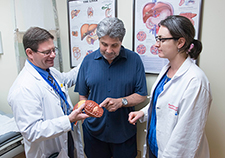Office of Research & Development |
 |
Hepatitis C, caused by the hepatitis C virus (HCV), is a condition marked by inflammation of the liver. Inflammation is swelling that occurs when tissues of the body become injured and infected. It can cause organs to not work properly. HCV infection can also lead to advanced liver disease, liver cancer, and early death.
HCV is spread through contact with the blood of an infected individual, such as through sharing needles when injecting drugs, by unsafe injection practices in health care facilities, in mother-to-child transmission during childbirth; and through sexual contact with an infected partner.
The symptoms of hepatitis C infection are often very mild. Most people can carry the virus for years and not notice any symptoms. The most common symptoms are vague abdominal discomfort, fatigue, and joint pains. Over time, HCV can cause other health problems, such as cirrhosis and liver cancer. Because the virus stays in the body, an infected person can give hepatitis C to someone else. People at risk for hepatitis C should consider getting tested. (A list of reasons to consider testing can be found here.) Blood tests are required to determine if HCV is present in the body.
Since early 2014, VA has treated HCV-infected patients with new, highly effective, less toxic, all-oral, direct acting antivirals (DAAs). These new drugs have fewer and less severe side effects and can be given as one pill a day for as short a treatment period as eight weeks.
VA has cured more than 100,000 Veterans with chronic HCV infection since 2014. Curing HCV can prevent the development or progression of advanced liver disease, cutting death rates by up to 50%. Until recently, HCV treatment required medication to be taken daily by mouth and weekly by injection for up to a year, with cure rates as low as 35%. In addition, this treatment had disabling medical and psychiatric side effects, which caused over half of patients to stop treatment prematurely.
Through the support of VA leadership, Congress, and Veteran advocacy, VA implemented an extensive and aggressive outreach and treatment program for Veterans. At the end of 2018, almost 85% of Veterans at increased risk for HCV had been tested, compared with 50% of the general U.S. population. At the peak of the effort to deploy DAAs, VA was starting a Veteran on HCV treatment every 72 seconds on a typical workday, with a rate of almost 2,000 new treatments each week.
In August 2019, it was estimated that fewer than 25,000 Veterans in VA care remain to be tested for HCV. Because of this historic effort, Veterans cured of HCV are estimated to be 72% less likely to develop liver cancer.
topVA research on hepatitis C includes clinical trials of treatments, epidemiologic studies, investigations of the biological mechanisms of infection, and studies on identifying and removing barriers to treatment.
Some VA researchers are working on projects to improve screening and testing methods for HCV. Others are working to improve the assessment and treatment of patients traditionally excluded from hepatitis C treatment, including those with mental illness, substance use, or who also are infected with HIV, the virus that causes AIDS.
Another area of interest to VA researchers is developing and disseminating models of interdisciplinary care to optimize treatment and clinical standards for treating patients at all stages of HCV infection.
If you are interested in learning about joining a VA-sponsored clinical trial, visit our research study information page.
Establishing trust is critical to completing treatment programs—In a 2019 study led by researchers at the Edith Nourse Rogers VA Medical Center in Bedford, Massachusetts, a team sought to understand factors that led to successful completion of the new hepatitis C treatment regimens from the perspectives of both Veteran patients and providers.
The team interviewed 38 Veterans from three New England VA medical centers and their health care providers. They found many patients were concerned about side effects of the treatment. Full explanations by providers of the new treatment’s side effect profile helped get patients to begin and continue with their treatment programs. Establishing trust between patients and providers also led patients to believe the new treatment could provide a cure, which increased the likelihood they would begin treatment and stay with the treatment until it was completed.
Hepatocellular carcinoma (HCC) calculator developed—HCC is the most common type of primary liver cancer in adults, and the most common cause of death in people with cirrhosis of the liver. The disease is closely linked to hepatitis B or C and exposure to toxins such as alcohol. Getting rid of the HCV through treatment significantly reduces the risk of developing HCC, although it does not entirely eliminate that risk.
A team led by researchers at the VA Puget Sound Health Care System has developed an online calculator that estimates a patient’s risk of developing HCC once their treatment is completed. The team developed the calculator based on a review of the health records of nearly 46,000 Veteran patients who started HCV antiviral treatment between 2009 and 2015. The team suggests that this calculator could enhance HCC surveillance efforts in patients, improve early detection of HCC, and decrease harms associated with needless surveillance for the cancer.
The 2018 study describing the model can be found here, and the model itself is available to clinicians at www.hcrisk.com.
Link between HCV and multiple cancers noted in the elderly—HCC has long been linked to HCV. A study published in 2017, led by researchers from the Michael E. DeBakey Medical Center in Houston and Baylor College of Medicine, looked at the Medicare records of more than 1.6 million patients 66 years of age and older, including patients with the HCV virus.
The team found HCV was associated with an increased risk of cancers other than HCC in elderly people, especially cancer of the bile duct and diffuse large B-cell lymphoma (the most common type of non-Hodgkin’s lymphoma, a cancer of the lymphatic system). Older patients with HCV may also be at increased risk of cancer of the pancreas or anus, some skin cancers, and myodysplastic syndrome, a kind of cancer in which the body cannot form enough healthy red blood cells.
The study also noted that although there is a high prevalence of HCV infection in “baby boomers,” less than 50% are aware of their infection, and fewer receive appropriate treatment. As this generation ages, therefore, the number of these cancers is likely to continue to rise.
In a 2016 study, members of the DeBakey/Baylor research team found that elderly Veterans with chronic hepatitis C are at a higher risk than younger Veterans of developing illnesses that make it less likely they will either receive or respond to antiviral treatment.
In the study, the team looked at the records of more than 160,000 Veterans with hepatitis C. These Veterans were divided into three age groups: 20–49, 50–64 and 65–85. They found that Veterans in the oldest group had the highest risk of cirrhosis, HCC, and death. They were also the least likely group to receive antiviral treatment.
The team concluded that while elderly patients have traditionally received less antiviral treatment, receipt of curative treatment is associated with a benefit in reducing those diseases and overall mortality, regardless of age.
Alcohol-related treatment low in hepatitis C patients—Alcohol use—particularly unhealthy alcohol use—exacerbates risk associated with HCV. Many patients with hepatitis C do not receive alcohol-related care, according to a 2018 study led by researchers with the VA Puget Sound Health Care System. The team looked at the electronic health records of more than 31,000 VA outpatients who had screened positive for alcohol use.
They found 72% had had a brief alcohol intervention, 13% received specialty addiction treatment, and only 3% had drug treatment for problematic use. For those who were diagnosed with alcohol use disorder, 27% used specialty addiction treatment and 6% used drug treatment. The findings highlighted the under-receipt of recommended alcohol-related care among patients with HCV, who are particularly vulnerable to the adverse influences of alcohol.
Accepting hepatitis C-positive liver transplants could improve life expectancy—In 1967, VA surgeon and researcher Dr. Thomas E. Starzl conducted the world’s first successful liver transplant. In 2018, a team including a researcher from the Michael E. DeBakey VA Medical Center in Houston published the results of a study in which they conducted a simulated liver transplant trial using a mathematical model.
The team found that accepting a liver for transplant regardless of the hepatitis C status of the donor resulted in increased life expectancy for the recipient over waiting for a liver free of HCV.
Although infected livers could have adverse outcomes, the team noted the virus can now be treated very effectively after the transplant is completed.
Best practices from VA noted—In 2017, a researcher from the VA Palo Alto Health Care System, along with senior department officials, published an article in which they noted VA’s significant success in curing its patients with HCV, including a greater than 90% cure rate.
The article noted that some of VA’s success came from its expansion of treatment capacity through the use of nonphysician providers, video telehealth, and electronic technology. Other reasons included the expansion of integrated care to address psychiatric and substance use issues and electronic data tools to track and reach out to Veterans. Regional multidisciplinary HCV innovation teams address gaps in care while providing more efficient and effective management of the illness for Veteran patients.
The commentary concludes that VA is poised to share and extend its best practices to other health care organizations and providers, to help reduce the overall burden of HCV infection throughout the world.
New risk protection tool—Researchers with the VA Ann Arbor Health Services Research and Development Center for Clinical Management Research and the University of Michigan have developed a new model using routine laboratory tests and machine-learning methods to help identify which patients chronically identified with HCV have the greatest need for new antiviral drugs. The results of their study were published in 2015.
According to the research team, hepatitis C will remain stable without treatment, perhaps for many years, in most patients. One-third of patients, however, are at high risk of complications and need immediate care to prevent the virus from causing further liver damage. These are the patients who would most benefit from the new HCV treatments.
Clinical data such as age, body mass index, virus type, and routine lab measurements estimated patients' risk of liver disease progression. Among the patients the model predicted would have a low risk of progression, only 6% developed cirrhosis (liver scarring) complications in the next year, compared with 56% of the high-risk group.
The team believes the risk-protection tool can be added to an existing electronic medical record, such as VA's, to help doctors make treatment recommendations. It can also establish how often patients should come in for doctor visits or have monitoring tests done.
HCV and mental health care—A 2015 study led by researchers at the VA San Diego Healthcare System looked at 363 Veterans with substance use or psychiatric disorders with HCV infections. They found that those Veterans who receive care that fully integrated support for their mental health issues and hepatitis C infection under the supervision of a care manager were more likely to receive antiviral therapy than those whose care was not integrated, and they were more likely to successfully complete that therapy and have undetectable virus loads.
Over a mean follow-up period of 28 months, 31.9% of Veterans with HCV infections receiving integrated care began receiving antiviral therapy, compared with 18.8% of those who did not. In addition, 15.9% of those who received integrated care completed the treatment regimen successfully, compared with 7.7% of those who received only usual care.
Osteoporosis is a condition in which bones become brittle and fragile from loss of tissue. It typically occurs as a result of hormonal changes or a deficiency of calcium or vitamin D. It leads to bones that are at an increased risk for fractures.
A number of studies have established that many people with HCV develop osteoporosis as they age.
Higher fracture risk—Researchers at the VA North Texas Health Care System and the University of Texas Southwestern looked at patients with HCV infections in a study published in 2016, and found that they, like patients with HIV infections, are at increased risk of developing osteoporosis and fractures—and that the risk is greatest for patients who have both HIV and HCV infections.
They found that patients with HIV and HCV have a threefold greater risk of developing fractures, compared with people who have neither infection, and that those with both infections also have significant additional risk compared to patients who are only infected with HIV.
The team believes that new tools that have been developed recently to assess the quality of people's bones may help researchers better understand why this is the case.
Veterans with HCV and cirrhosis are significantly less likely to die or to progress to a stage in liver disease called decompensated cirrhosis if they use statins to control blood cholesterol. Patients with decompensated cirrhosis are at significant risk of dying unless they receive a liver transplant.
Statins and cirrhosis risk—In a study published in 2016, a team from the VA Connecticut Healthcare System and Yale University looked at the health records of 685 statin users with HCV and cirrhosis seen at VA outpatient clinics between 1996 and 2009. Their health status was compared with that of 2,062 patients with the same illnesses who did not use statins.
Over a follow-up period of more than two years, statin use was associated with more than a 40% reduction in the risk of death or decompensated cirrhosis. These associations persisted after statistical adjustments for other health care variables associated with liver disease.
The team concluded that until randomized controlled trials are conducted, statins cannot be widely recommended for all people with HCV and cirrhosis, but patients with HCV who would require statins for other health issues such as high cholesterol should be prescribed those drugs.
Statins and antiviral treatments—Researchers from the VA Pittsburgh Healthcare System reported in 2015 that statins improved outcomes among Veterans receiving antiviral treatment for hepatitis C. The researchers followed 7,248 hepatitis C patients who received antiviral treatment for at least 24 months after completing therapy. Of those patients, 45% received statins.
Those who used statins were significantly more likely to have a sustained response to antiviral therapy, compared with those who did not (39% versus 33%). Statin users were also less likely to progress to cirrhosis (17% versus 25%) or to develop liver cancer (1.2% versus 2.6%).
According to the research team, the data support the use of statins in patients with HCV.
Hepatitis B (HBV) is a contagious liver condition that can range from a severe acute illness lasting a few weeks to a slow-progressing but serious lifelong ailment. It shares symptoms and some risk factors with HCV, but HCV is more common in the United States.
Most acute cases of HBV clear up within a few months, with no lasting effects—but about 1 in 10 adults develops a chronic infection, and 1 in 5 patients with chronic infections might develop liver failure, cirrhosis, or liver cancer. The infection is tied to as many as 4,000 deaths each year in the United States.
Many individuals have both hepatitis B and hepatitis C infections. In 2016, the U.S. Food and Drug Administration (FDA) warned that DAAs might reactivate the hepatitis B virus in those infected with both viruses.
In a 2019 study, non-VA researchers evaluated the medical records of more than 33,000 patients with both viruses and found that the FDA’s concern might not be warranted. In an editorial accompanying the study, a researcher from the VA Puget Sound Health Care System stated that the study should “put to rest” the safety concerns raised by the FDA. There is no downside, explained the VA researcher, in increased hospitalization or death for those taking DAAs.
Concerns about direct-acting antiviral agents for Hepatitis C- cause for reassurance. Beste LA. Direct-acting antiviral therapy is not associated with excess treatment-related risks to patients. JAMA Netw Open. 2019 Jun 5;2(6):e1954757.
Experiences with interferon-free hepatitis C therapies: addressing barriers to adherence and optimizing treatment outcomes. Skolnick AA, Noska A, Yakovchenko V, Tsai J, Jones N, Gifford AL, McInnes DK. Despite the improved side-effect profile of newer HCV medications, multiple barriers to treatment completion remain. BMC Health Serv Res. 2019 Feb 1;19(1)91.
Development of models estimating the risk of hepatocellular carcinoma after antiviral treatment for hepatitis C.Ioannou GN, Green PK, Beste LA, Mun EJ, Kerr KF, Berry K. The research team has developed and validated models estimating hepatocellular carcinoma risk after antiviral treatment that can be used to guide screening strategies. J Hepatol. 2018 Nov;69(5):1088-1098.
Receipt of alcohol-related care among patients with HCV and unhealthy alcohol use.Owens MD, Ioannou GN, Tsui JL, Edelman EJ, Greene PA, Williams EC. Many patients with hepatitis C do not receive recommended alcohol-related care. Drug Alcohol Depend. 2018 Jul 1;188:79-85.
Transplanting hepatitis C virus-positive livers into hepatitis C virus-negative patients with preemptive antiviral treatment: a modeling study.Chatwal J, Samur S, Bethea ED, Ayer T, Kanwal F, Hur C, Roberts MS, Terrault N, Chung RT. Patients without hepatitis C needing a liver transplant may have increased life expectancy if they are willing to accept a donated liver that is positive for the hepatitis C virus. Hepatology. 2018 Jun:67(6):2085-2095.
Curing hepatitis C virus infection: best practices from the U.S. Department of Veterans Affairs.Belperio PS, Chartier M, Ross DB, Alaigh P, Shulkin D. VA is poised to share and extend best practices to other health care organizations and providers delivering HCV care, contributing to a concerted effort to reduce the overall burden of HCV infection. Ann Intern Med. 2017 Oct 3;167(7):499-504
Persisting risk of hepatocellular carcinoma after hepatitis C virus cure monitored by a liver transcriptome signature.Ono A, Goossens N, Finn RS, Schmidt WN, Thung SN, Im GY, Hoshida Y; Precision Liver Cancer Prevention Consortium. Screening for liver cancer at the molecular level for high-risk patients can help manage the disease. Hepatology. 2017 Oct:66(4):1344-1346.
Transplantation of kidneys from hepatitis C-positive donors into hepatitis C virus-infected recipients followed by early initiation of direct acting antiviral therapy: a single-center retrospective study. Bhamidimarri KR, Ladino M, Pedraza F, Guerra G, Mattiazzi A, Chen L, Ciancio G, Kupin W, Martin P, Burke G, Roth D. Kidney transplants from deceased donors positive for hepatitis C antibodies could shorten transplant wait times for patients with hepatitis C when antiviral drugs are administered early. Transpl Int. 2017 Sep;30(9):865-873.
“Where’s my choice?” An examination of Veteran and provider experiences with Hepatitis C treatment through the Veteran Affairs Choice program. Tsai J, Yakovchenko V, Jones N, Skolnik A, Noska A, Gifford AL, McInnes DK. Enhancing care coordination, incorporating shared decision-making, and establishing a wide network of community providers may be important areas for further development in designing community-based specialist services for needy Veterans. Med Care. 2017 Jul;55 Suppl 7 Suppl 1:S13-S19.
Hepatitis C virus infection and the risk of cancer among elderly US adults: A registry-based case-control study.Mahale P, Torres HA, Kramer JR, Hwang LY, Li R, Brown EL, Engels EA. HCV is associated with increased risk of cancers other than HCC in the U.S. elderly population, notably bile duct cancers and diffuse large B-cell lymphoma. Cancer. 2017 Apr 1;12(7):1202-1211.
Statin drugs decrease progression to cirrhosis in HIV/hepatitis C virus coinfected individuals.Oliver NT, Hartman CM, Kramer JR, Chiao EY. Statin drug use is beneficial in mitigating the risk of liver disease progression for HIV/HCV coinfected patients without advanced liver disease. AIDS. 2016 Oct 23:30(16):2469-2478.
Effectiveness of Sofosbuvir, Ledipasvir/Sofosbuvir, or Paritaprevir/Ritonavir/Ombitasvir and Dasabuvir regimens for treatments of patients with hepatitis C in the Veterans Affairs national health care system.Ioannou GN, Beste LA, Chang MF, Green PK, Lowy E, Tsui JI, Su F, Berry K. New drug regimens for hepatitis C have resulted in remarkably high cure rates among VA patients. Gastroenterology. 2016 Sep;151(3):457-471.e5.
Epidemiology and outcomes of hepatitis C infection in elderly US Veterans.El-Serag HB, Kramer J, Duan Z, Kanwal F. Elderly patients with chronic hepatitis C are more likely to develop hepatocellular carcinoma than younger patients but have traditionally received less antiviral treatment than younger patients. However, receipt of curative treatment is associated with a benefit in reducing cirrhosis, HCC, and overall mortality, irrespective of age. J Viral Hepat. 2016 Sep;23(9):687-96.
Hepatitis C virus coinfection as a risk factor for osteoporosis and fracture. Bedimo R, Maalouf NM, Re VL 3rd. Chronic HCV infection is an independent risk factor for osteoporosis and fractures among HIV-infected patients, even before the development of cirrhosis. Curr Opin HIV AIDS. 2016 May;11(3):285-93.
Statins are associated with a decreased risk of decompensation and death in Veterans with hepatitis C-related compensated cirrhosis.Mohanty A, Tate JP, Garcia-Tsao G. Statin use among patients with HCV and compensated cirrhosis is associated with a more than 40% lower risk of cirrhosis decompensation and death. Gastroenterology. 2016 Feb;150(2):430-440.e.1.
Integrated care increases treatment and improves outcomes of patients with chronic hepatitis C virus infection and psychiatric illness or substance abuse.Ho SB, Brau N, Cheung R, Liu L, Sanchez C, Sklar M, Phelps TE, Marcus SG, Wasil MM, Tisi A, Huynh L, Robinson SK, Gifford AL, Asch SM, Groessl EJ. Integrated care increases the proportion of patients with HCV infection and psychiatric illness or substance abuse who begin antiviral therapy and achieve a sustained virologic response without serious adverse effects. Clin Gastroenterol Hepatol. 2015 Nov:13(11):2005-14.e1-3.
Effectiveness of sofosbuvir-based regimens in genotype 1 and 2 hepatitis C virus infection in 4026 U.S. Veterans. Backus LI, Belperio PS, Shahoumian TA, Loomis TP, Mole LA. In a real world cohort, sustained virologic response rates for sofosbuvir-based regimens were lower than in clinical trials. Aliment Pharmacol Ther. 2015 Sep;42(5):559-73.
Effect of addition of statins to antiviral therapy in hepatitis C virus-infected persons: results from ERCHIVES.Butt AA, Yan P, Bonilla H, Abou-Samra AB, Shaikh OS, Simon TG, Chung RT, Rogal SS; ERCHIVES Study Team. Statin use was associated with improved virologic response rates to antiviral therapy and decreased progression of liver fibrosis and incidence of hepatocellular cancer among a large cohort of HCV-positive Veterans. Hepatology. 2015 Aug;62(2):365-74.

Download PDF
 Hep C-positive organs, safe and effective for most transplant recipients
Hep C-positive organs, safe and effective for most transplant recipients
 Study: Combat a possible risk factor for hepatitis B
Study: Combat a possible risk factor for hepatitis B
 Abnormal gut bugs tied to worse cognitive performance in Vets with PTSD and cirrhosis
Abnormal gut bugs tied to worse cognitive performance in Vets with PTSD and cirrhosis
 Treating liver cancer: Access to 'best care' critical to survival
Treating liver cancer: Access to 'best care' critical to survival